Arts & Culture
About Andrew Cusack
 Writer, web designer, etc.; born in New York; educated in Argentina, Scotland, and South Africa; now based in London.
Writer, web designer, etc.; born in New York; educated in Argentina, Scotland, and South Africa; now based in London. read more
News
Blogs
Reviews & Periodicals
Arts & Design
World
France
Mitteleuropa
Knickerbockers
Argentina
The Levant
Africa
Cape of Good Hope
Netherlands
Scandinavia
Québec
India
Muscovy
Germany
Academica
Res Publica Nova Eboraci

Gothamist picks up the idea of the City of New York seceding from either the State or the Country. Normally I’m in favor of anything seceding from anything else. However, the City and State have to stick together. I wouldn’t mind the State of New York regaining complete sovereignty, but I think we’d want to take Connecticut and northern New Jersey with us for the sake of geographic integrity.
New York currency illustrations from an article on secession in New York magazine.
Leisure
I AM BACK HOME in New York after having completed my Martinmas term examinations. This morning, my mother, sister, brother-in-law, and I went out for breakfast to celebrate my “triumphant return from another term at university.” (I suggested it might be wiser to wait until the casualty reports are released before we declare it a triumph).
Nonetheless, I now have three weeks of time almost entirely free from obligations to do whatever I please. It is perhaps how a man spends his free time that defines him, as free time is the foundation of civilization itself. Roger Kimball reflects on this in a recent Armavirumque posting, mentioning Josef Pieper and Leisure: The Basis of Culture, a book I was first introduced to by Robert O’Brien whilst still half-asleep at 7:30 in the morning waiting for a train at Leuchars station so we could attend the Tridentine mass in Edinburgh.
Leisure, by which we mean doing something merely for its own sake, is entirely different from mere pleasure. Unfortunately for the English language, we oft mistake the two for synonyms. It is leisure in that latter sense, of idleness and cheap pleasure, which our good friend Prof. Richard Demarco resoundly condemned in a lecture he gave at St Andrews. This kind of leisure, he stated, was leading to the destruction of Scotland, of Europe, and of civilization. Art today, according to Richard, is a collection of usually talentless kitsch which seeks merely to create an arrangement that is pleasing or clever. Art, in Richard Demarco’s world, should not aim to be pleasing, or to be clever, but should have as its essence the very highest that man can achieve: the sanctification of souls. In pursuit of pleasure rather than leisure, tourism is taking over entire countries; a false economy which can enslave the entire population of a given area.
It is certainly rampant in St Andrews. There are many good reasons to visit St Andrews. The third-oldest university in the English-speaking world, for example, or perhaps to see ruins of one of the greatest shrines in Christendom, bearing witness to the visceral damage wrought by the Protestant Revolution (we should refuse to dignify that revulsion with the name of ‘reformation’; it destroyed and replaced, not reformed). Most, however, come for the golf.
While niches once full remain empty from the holocausts of five centuries ago, the Scottish Parliament would prefer to spend its millions (which, you must never forget, are the people’s millions) on encouraging this pointless and ineffective idleness, Demarco pointed out. More recently, South Street, where I live, will soon be shorn of its beautiful trees, those which make it one of the most inviting and comely thoroughfares in the Royal Burgh. This must be done, we are told, to increase the number of parking spaces, the paucity of which might be driving away potential tourists. Perish the thought! Heaven forbid a town be run for the benefit of its inhabitants, for the benefit of itself (but surely by now they have already forbidden Heaven).
As Mr. Kimball points out, the opposite of the former leisure, the leisure which Pieper posits is the basis of culture, is busyness. Perhaps we can extend this to business, for it is the dollar, the pound, and the euro which enslave St Andrews to transient tourists. Without tourism, some say, St Andrews, or Oxford or Venice or wherever, would not survive. But at what price survival? And who defines this survival? That these places are still on the map and are inhabited is for sure. But in some sense have not these places, while encouraging tourism as a mode of survival, been so changed and transformed that in fact they have not survived. Decrepit and rundown, they may have been, but at least they had authenticity; at least they were themselves. Now most of the goods sold in St Andrews – saltires, fake kilts, tam o’shanters, and Scotland t-shirts – are in fact things that can be purchased in half the towns in Scotland, and now with the advent of the internet, you can purchase them while you remain at home. Their cheapness is only accompanied by the sentiment of being a souvenir in the original French sense of the word: to remember. But they are remembrances for short memories, and likely will be thrown out within a year, because we, and it all comes back to this, do not have the time for longer memories.
Thus one of the chief values of an education must be free time. St Andrews affords this, I am glad to say; especially if you are an arts student and are not aiming for a first. All too often friends of mine at universities in the States or at Oxbridge are busy. They are either busy with busywork, (assignments for school which must be done to stay in the university but have little graded value or academic merit) or else busy with social activity and other amusements which vary greatly as to whether one’s in a big city or not (most often the case with NYU students I find).
When I finally start my university, we must make sure that students have enough free time then, perhaps the greatest argument for not locating it in an overactive urban metropolis. Though of course a good part of education is that which transmits information and ideas and, more importantly, inculcates moral values, much must be left up to the student. There is an inherent value in reading not what is required but what is desired.
And so I will get on with my post-exam break, reading the Pickwick Papers, the Everlasting Man, and This Side of Paradise, hopefully with some time to browse through Haldane’s Faithful Reason: Essays Catholic and philosophical (which, on a typographical note, makes ample use of the Gill Sans font).
Warner on the Gotha
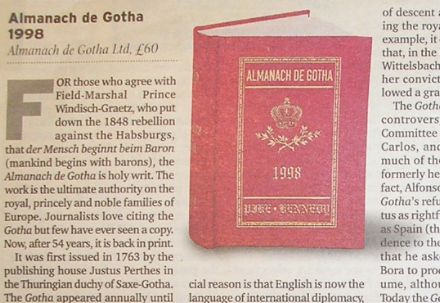
Whilst rummaging through my room at home in New York last week, I came across this article which I had cut out of the ill-fated European in 1998 written by none other than Mr. Gerald Warner, KM. I was fourteen years old in 1998 and the European folded about a year later. Click here to read in jpg form. (A large file, some browsers may require resizing to view the text at a readable size).
University College Durham
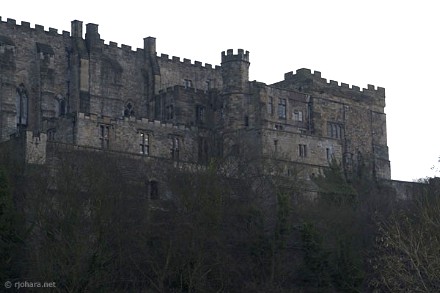
Dr. Robert O’Hara (who runs one of my favorite website) recently took it upon himself to visit the University of Durham and provided a few snapshots. Of most interest to me is University College Durham, situated in ancient Durham Castle. I think perhaps when I start my university our very first college might be partly modelled on this. (more…)
Dingbat Through the Ages

Newsdesigner.com has an interesting post enlightening us to the history of the ‘dingbat’, the vignette which can be found atop the International Herald Tribune.

The design first originated in the nameplate (also called, varyingly, the ‘masthead’, ‘banner’, or ‘flag’) of the New-York Tribune. The Tribune became the New York Herald Tribune, which my Aunt Naomi informs me was a very good newspaper while it lasted. The NYHT died in 1966, being merged into the ill-fated New York World Journal Tribune (aka the Widget) which only produced a few numbers before labor troubles killed it too.

The Herald Tribune, however, has two remnants which still exist today: the Paris edition (now the IHT) which continued under the auspices of the New York Times and the Washington Post, now solely owned by the Times; and New York magazine, which started out as a weekly supplement to the Herald Tribune.
Wallabout Market

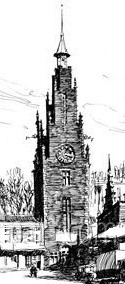 New York’s Wallabout Market was once the second-largest market in the world. From about 1884 onwards, vendors would gather in this district adjacent to Wallabout Bay in Brooklyn and sell their various wares. It was then that the market vendors had been banned from Fulton Street for making too much noise, and so took up their trades further down by the Wallabout Canal, next to the New York Naval Shipyard, more commonly known as the Brooklyn Navy Yard (founded 1801, decommissioned 1966).
New York’s Wallabout Market was once the second-largest market in the world. From about 1884 onwards, vendors would gather in this district adjacent to Wallabout Bay in Brooklyn and sell their various wares. It was then that the market vendors had been banned from Fulton Street for making too much noise, and so took up their trades further down by the Wallabout Canal, next to the New York Naval Shipyard, more commonly known as the Brooklyn Navy Yard (founded 1801, decommissioned 1966).
The market featured permanent two-story brick structures designed in a nostalgic Dutch style, commemorating the Netherlandish origins of New York and Brooklyn, centered around an open plaza known as Farmers’ Square where stalls were erected. The centerpiece was a tall clock tower, seen at right and further below.
The market buzzed with activity from about midnight until just after dawn, by which time trading had died down. During the majority of the daylight hours the vast market stood empty. (more…)
St. Paul’s, Eastchester
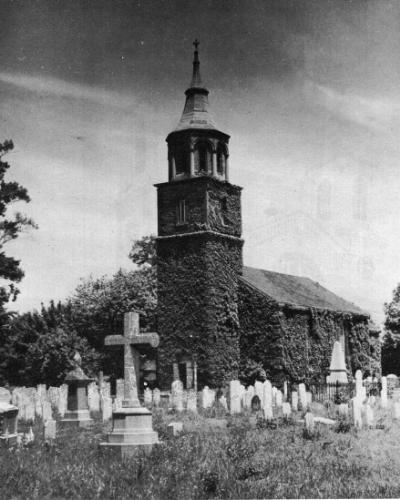
One of the hidden gems of our county is St. Paul’s Church, Eastchester. The church has been within the City of Mt. Vernon since the late 19th century, but was the original town church for Eastchester, situated on the village green. The first church building on the site, a simple wooden structure, was built in 1692. The current structure was built in 1763, with numerous additions and subtractions since that date. (more…)
L’Église de St. Jean Baptiste, New York
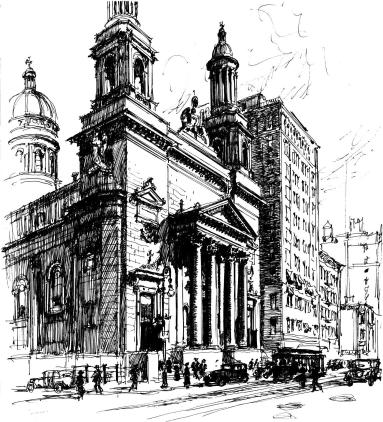
A comment of Mr. Hiss on Fr. Sibley’s blog mentioned the Church of St. Jean Baptiste on the Upper East Side. There are few churches in New York, let alone all America, which are as beautiful as St. Jean Baptiste (or “St. JB’s” as people ridiculously call it). A restoration only a few years ago brought the church back to its full splendour.
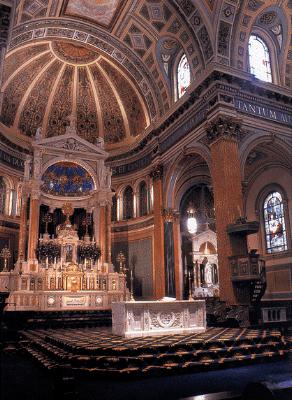
It used to be the national parish of the French Canadians in New York, hence the French name, and is now home to the National Shrine of St. Anne, formerly further downtown in what became St. Anne’s Armenian Catholic Cathedral (one of a few beautiful and very active church buildings being pawned off by the wretched bureaucrats who run the Archdiocese of New York).
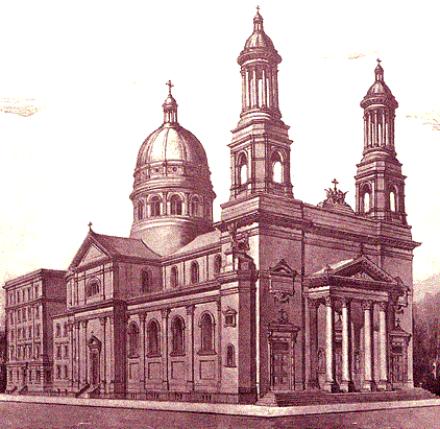
The church is open most of the day and definitely worth stepping into even if you only have a few minutes. Their parish website (link above) has a somewhat detailed history of the parish and the architecture of the church.
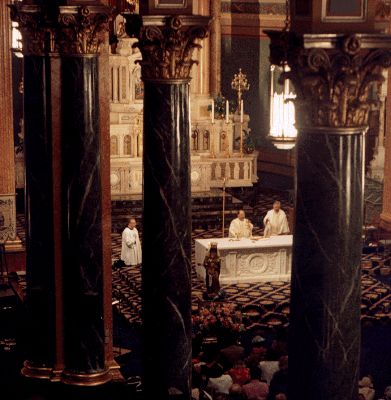
The parish and girls’ high school are now staffed by priests of the Congregation of the Blessed Sacrament as well as sisters from the Congrégation de Notre-Dame, and the Body of Christ is adored all day long except during Mass.
If London Were Like New York
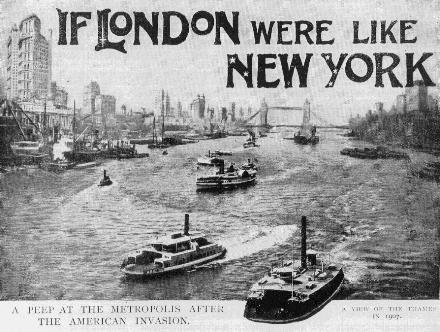
I stumbled upon this rather drole piece from 1902 about the prophesized New-Yorkification of London in Harmsworth’s Magazine. “If London Were Like New York: A Peak At The Metropolis After The American Invasion” is accompanied by some amusing illustrations of the anonymous authors vision of the future.
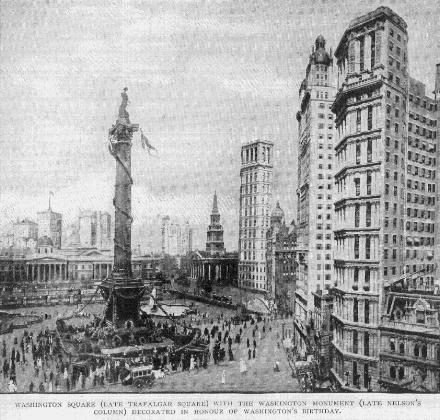
Trafalgar Square is rededicated to George Washington, and decorated to celebrate his birthday.
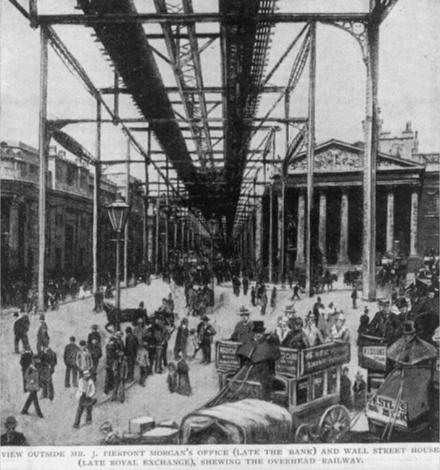
An el is built right through the heart of the City.
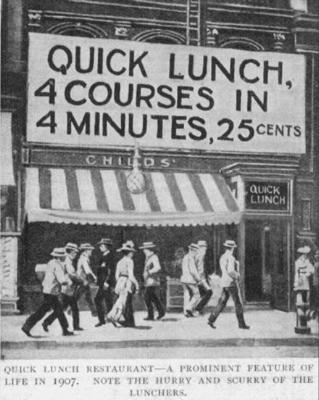
There’s even a precursor of our famous American fast food. Perhaps the most prophetic of the author’s predictions!
Les Halles Will Get a Makeover
For the architectaphiles in the audience, the designs for the complete do-over of les Halles (one of Paris’s urban eyesores) are out.
Le Figaro‘s take on it.
Images of the accepted design and rejected proposals from le Figaro.
The New York Times writes on it as well. (Registration might be required).
The Oldest Library in New York
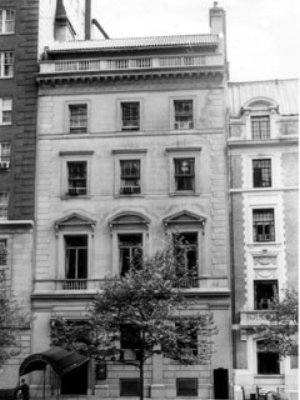
When one thinks New York and thinks libraries, the obvious place which comes to mind is the New York Public Library, one of the largest libraries in the world with one of the most beautiful homes in Bryant Park on 42nd St. 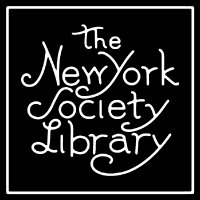 The Public Library was formed in the mid-19th century by a merger of the private Astor, Lennox, and Linden libraries. The great metropolis, however, is home to a much older bibliotheca called the New York Society Library, founded in 1754.
The Public Library was formed in the mid-19th century by a merger of the private Astor, Lennox, and Linden libraries. The great metropolis, however, is home to a much older bibliotheca called the New York Society Library, founded in 1754.
In that year, six ‘civic-minded individuals’ formed the New York Society with the aim of founding a library which would be “very useful as well as ornamental to the city”. The ‘city library’ was given a room in the old City Hall (later, as Federal Hall, home to the United States Congress), and received a charter from H.M. King George III in 1772. Unfortunately the Library was looted during the Revolution, but survived and was restocked afterwards, receiving a second charter from the Assembly of the State of New York.
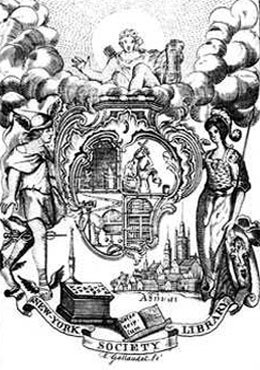
The Society Library is still, as it was then, a subscription library which operates almost like a private club, though open to all who will subscribe (and the Society Library’s membership fee is much more economical than a club). The N.Y.S.L. merged with the New York Athenaeum in 1840, and having been located a various locations around lower and mid Manhattan, in July 1937 moved its collection of one hundred and fifty thousand volumes into 53 East 79th Street (seen at top), where it continues today.
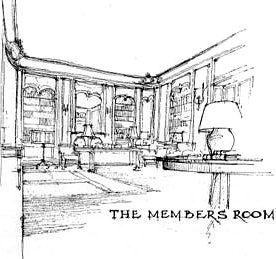
I’ve never been to the Library myself, though it seems a suitably comfortable and private location to read or research, and not expensive to boot. Perhaps I will strike up a subscription when I am next in New York as a full-time resident. They even have a Children’s Room which would be useful when progeny appear.
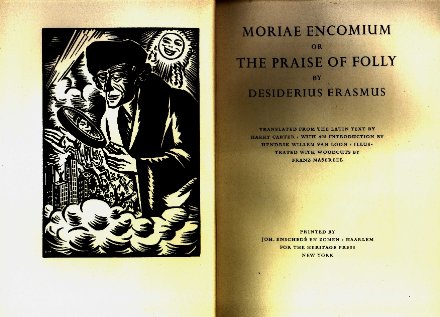
Back in Bronxville
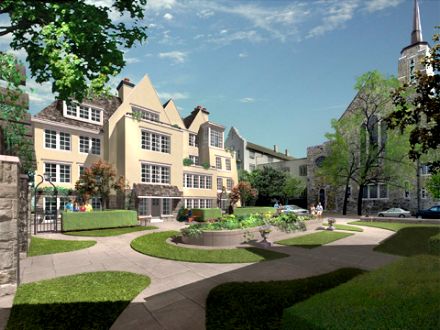
Robert A.M. Stern has apparently designed a proposal for the site of the old Gramatan garage in Bronxville, behind Christ Church. I have to admit that once the garage was torn down I began imagining the possibilities for the site. Christ Church, by Grosvenor Goodhue the Great (responsible for St. Vincent Ferrer and the Cadet Chapel at West Point among others), is such a beautiful building, and Stern’s design deftly fits into the context.
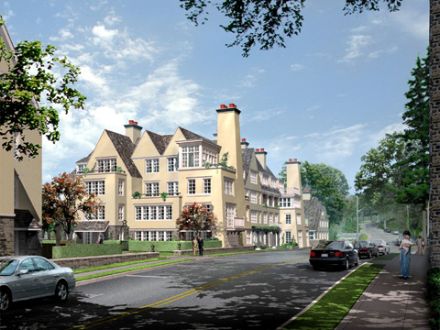
The design is along the lines of the nearby Kensington Gardens and the other courts of townhouses which are dotted around that area and elsewhere in Bronxville. It seems to be an apartment building, probably along the lines of the Avalon building (previously home to Emma, Lilly, and Momma Kate Haberl, and Roger Mahon too), though of a much better design.
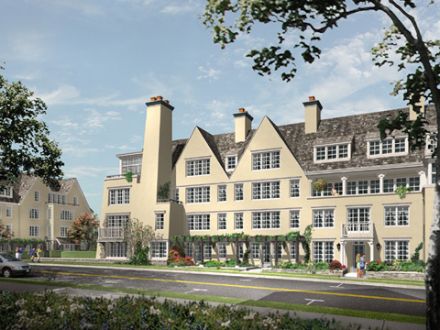
It is, however, a slightly odd mix of buildings that one finds surrounding Christ Church. Immediately to the north are the modern church house and a Spanish Mediterranean building, across Sagamore Road are brick neo-Tudor buildings, and up the road are mock English village structures of the ilk this design emulates. Still, altogether it somehow works, though Christ Church is oddly enough an arts-and-crafts reinterpretation of English Gothic with a Spanish-style courtyard featuring a statue of St. Francis of Assisi. Bizarre, but it all works somehow.
A Good Point
John Lukacs, in his A Student’s Guide to the Study of History, says in a footnote:
This is my essential point about architecture today. If one looks at the actual built quality of buildings by Duncan Stroik or Thomas Gordon Smith, one may appreciate the overall idea or effort but frown upon the execution, call it clumsy or whatnot. The point is that though these people may or may not be masters themselves, they are raising a new generation of architects who are in tune with the past and thus able to more readily plot a future of beauty and mastery. With any luck, within 50-100 years, architecture will have recovered from the uninspiring malaise in which it currently dwells.
The Remarkable Hapsburgs

Last night, Fr. Emerson popped up from Edinburgh and gave a talk on the Hapsburg dynasty. It was tremendously interesting. I learned so much I hadn’t known before and it opened up a terrific number of avenues of information down which I have only begun to stroll.
I had no idea how remarkable a man Franz Ferdinand was. All they teach you in America is “This is the guy who got shot” instead of “This man would have been the savior of all that is good and holy in Europe.”
I have seen and read a lot of what Europe is today; Fr. Emerson gave us a glimpse of what Europe was yesterday, before the utter destruction of the social order of the continent by that moment in Sarajevo and everything that came after it. Knowing what Europe was, how depressing to see it now!
It also filled me with some optimism, oddly enough. I used to be partly in the school of thought that’s convinced that Europe is lost. If this is how Europe was, surely it could be again? Perhaps, perhaps not. (more…)
‘New Yorkism’
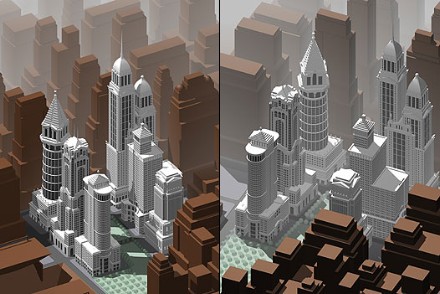
The latest edition of the City Journal presents a wonderful vision for Hell’s Kitchen, the Manhattan neighborhood which has been slated for a massive redevelopment. The Journal commissioned a number of the world’s leading classicists in the field of architecture to design skyscrapers that fit into the City Planning Commission’s recommendations for the new ‘Hudson Boulevard’ which is planned for the ‘Far West Side’ (the newest catchy rebranding for Hell’s Kitchen since ‘Clinton’ failed to take off).
Dutch Church, Kingston
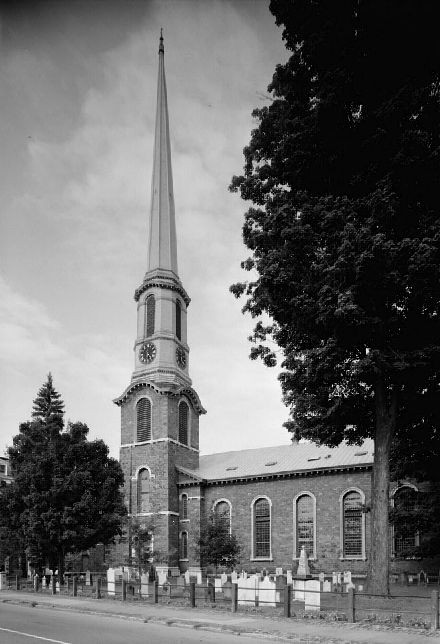
The Dutch Reformed Church in Kingston, New York.
The Maine Monument et cetera
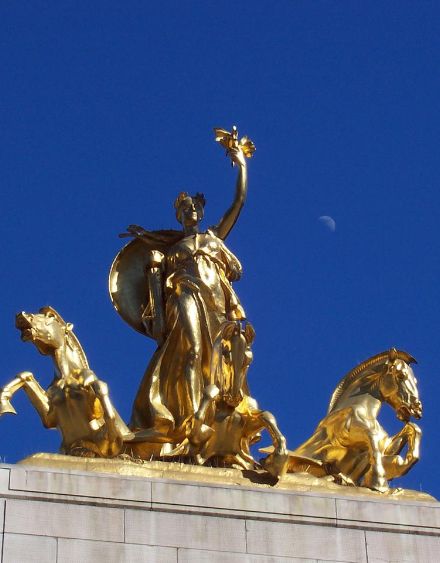
The Maine Monument has always been one of my favourite monuments in New York. It’s dedicated to the dead of the U.S.S. Maine incident and the Spanish-American War. The Monument is beautiful, not only due to its intriguing massing and beautiful sculpted work, but also because its placement in relation to Columbus Circle. It moves upward, encompassed in the lush greenery of Central Park behind it, and the bottom half projects itself forward into the Circle and creates a pleasing visual arrangement.
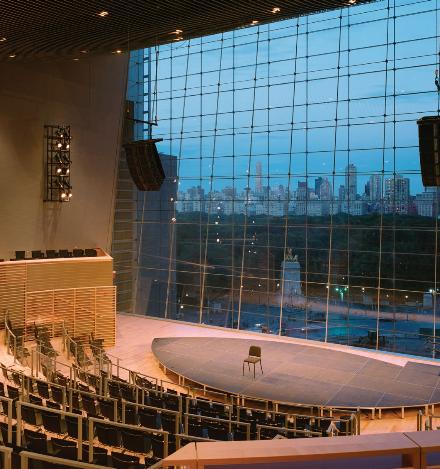
Above, as seen through the window of the Allen Room of the new Frederick P. Rose Hall at the AOL Time Warner Center. According to the review of opening night in the Sun, the Allen Room’s acoustics are amazing, and it looks as if Rose Hall will be an important addition to the cultural world of the City. (Note to Lucas and Adam: pencil this into your schedules).
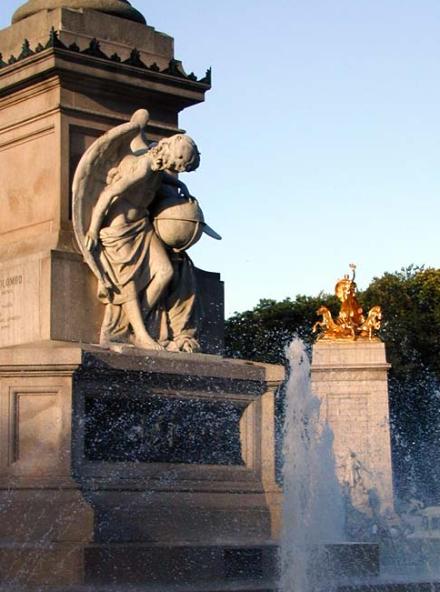
Above the Maine Monument is pictured with the base of the Columbus column in the middle of Columbus Circle. The Circle is currently undergoing a massive refurbishment to try to make it more accesible and parklike rather than just a glorified traffic circle.
Top photo by Corin Anderson
Recent New York Art
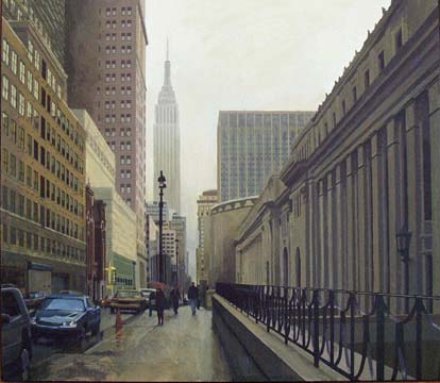
I am a philistine. The reason I am a philistine is because when it comes to art, I only like what I find beautiful. Today in the world of art, you’re supposed to appreciate art for the ideology and thought that goes behind it. If you only like what’s beautiful, then you are a philistine. I am quite happy being a philistine and hope I remain a philistine for the rest of my life.
Nonetheless, there have been a few recent works of art I felt I ought to show you. The common theme is New York. (more…)
Albany
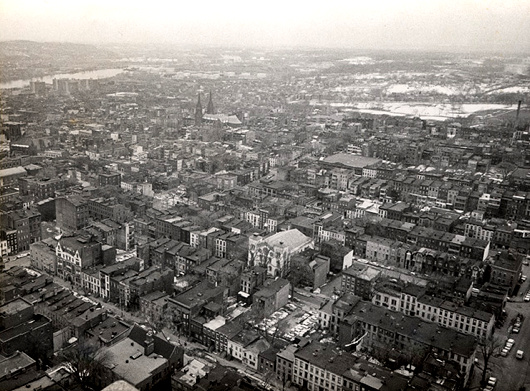
This photo of Albany, the capital of New York, from the 1950s shows a city that, if it weren’t for the straight streets, almost feels like a poverty-stricken Eastern European capital.
Unfortunately, it became even more like a poverty-stricken Eastern European capital when Big Brother decided to get rid of it all and replace it with a giant, heartless, government plaza.
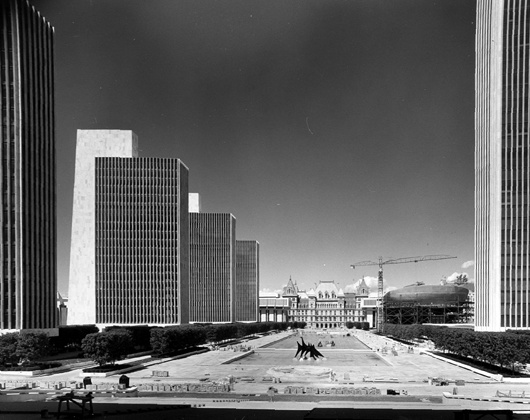
I wonder if Governor Rockefeller visited Brasilia and thought “Gee, I ought to get me one of them!” Empire State Plaza (or Governor Nelson A. Rockefeller Empire State Plaza as it is now officially known) involved the displacement of thousands of poor people, hundreds of small businesses, bad architecture, and the humongous cost – partly owing to the omnipresent use of marble instead of more economic stones.
The result was the destruction of a large community built on a human scale in favor of an expensive, espansive, inhospitable Communist dreamland on the Hudson. A crime.
Search
Instagram: @andcusack
Click here for my Instagram photos.Most Recent Posts
- Amsterdam November 26, 2024
- Silver Jubilee November 21, 2024
- Articles of Note: 11 November 2024 November 11, 2024
- Why do you read? November 5, 2024
- India November 4, 2024
Most Recent Comments
Book Wishlist
Monthly Archives
Categories



